For your calendar:
OLANs - Optical LANs - CI&M Webinar March 27
FOA will be working with Cabling Installation and Maintenance magazine to present our third webinar - this time on OLANs - POLs & FTTO. We will cover the history of cabling for LANs and look at the evolution of fiber optic cabling for today's high speed networks.
More on the webinar at http://www.cablinginstall.com/webcasts/2013/03/passive-optical-lans.html
Register at http://video.webcasts.com/events/pmny001/viewer/index.jsp?eventid=45518&adid=ws
Sometimes Standards Can Make Sense (The "mandrel" is back!)
For years now, the TIA TR-48.11 standards committee has been grappling with updating the means to control mode power distribution in multimode fiber measurements in order to create reproducible test conditions. The topic is nothing new, going back to the early 1980s, at one time or another endorsing optical launches (70/70), mode conditioning mandrels, mode conditioning "black boxes," etc. and using different methods to specify and measure the results, including mode power distribution (MPD), couple power ratio (CPR) and most recently in the new version of OFSTP-14 encircled flux (EF). EF has been the subject of lots of discussion, bad science experiments and marketing hype, frustrating practically everybody that has come in contact with it. It's been the source of some humor too, like the contractor who called to tell us he had seem a contract that called for a "flux capacity" test!
At the TIA meeting this month, a proposal was created to make EF only applicable to 850nm testing of 50/125 fiber at <3dB, a common sense approach since new multimode fiber of this type is the only fiber intended for the speeds (10Gb/s) for which EF was intended. Other fibers (62.5/125) and wavelengths (1300nm) will then be covered by a new version of the mandrel wrap mode conditioner that has been around for twenty years or more.
The difference is the mandrel wrap now has a new calibration routine. You use a LED source, wrap the fiber around the mandrel and measure the light lost by the mandrel wrap. That is a measure of how much you strip the higher order modes from the fiber and yields a more reproducible launch for testing. The amount of loss caused by the mandrel is still being worked on, but 0.3-0.6dB looks about right. There is even an awkward acronym, HOML for higher order mode loss, that needs replacing.
All this is very sensible. In addition, the other bug in the recent updated version of OFSTP-14, the allowing of OTDRs as well as a light source and power meter to measure cable plant loss, is being disucssed. At the latest meeting, discussions were held about the problem with mode conditioners, in that most of these devices are not bidirectional, a necessity for OTDR testing. Expect clarification of this issue in the future. And the work justifying the acceptance of OTDR data relates to 50/125 fiber at 850 nm with no more loss than 2 dB. Work needs to be done.
Another multimode testing issue remains unsolved - testing of and with bend-insensitive (BI) fibers. At this time, BI fibers are not recommended for use as reference cables for testing as there may be coupling issues with regular MM fibers and even other designs of BI fibers. This is problematic as some manufacturers only make BI MM fibers. At least one of those is recommending using a tiny (~3mm) mandrel to condition launch cables. Confusing?!
The OSP "Crystal Ball"
OSP Magazine interviewed a bunch of telco executives for their January 2013 issue, asking for their predictions for the new year. Here are some of our favorite quotes.
"Reduced investment will be made to build new copper networks. In fact, areas with really bad report rates will drop copper and serve everyone with fiber if FTTP (fiber to the premises - ed.) is available in that area." Telcordia
"I think 2012 will see more discussion about moving from copper to fiber. We know that fiber's advantages -- reliability, capacity, scalability, quality -- help future proof networks to support high bandwidths, provide greater efficiencies and enable quicker restoration." Verizon
"These managed networks will require access to higher bandwidth symmetrical services, which many of us believe can best be met by fiber." AT&T
"Telcos need to continue the evolution to an all-fiber network." RST Global Communications
When Will the Rest of Us Get Google Fiber?
Google may choose to expand its service, but there’s little incentive for established players to come up to speed. Leave it to MIT Technology Review to get to the heart of the matter. "In parts of the country, slower-speed copper, fast-download cable, and a few fiber networks are already built out. The cable distribution giants like Time Warner Cable and Comcast are already making a 97 percent margin on their “almost comically profitable” Internet services, according to Craig Moffet, an analyst at the Wall Street firm Bernstein Research. As Levin points out, “If you are making that kind of margin, it’s hard to improve it.” And most Americans have no choice but to deal with their local cable company."
Read More.
FCC Wants Gigabit Ethernet In 50 States By 2015
The Federal Communications Commission (FCC) has issued a challenge to bring gigabit Ethernet speeds to all US states within the next two to three years. Specifically, the FCC wants to see gigabit Ethernet speeds deployed in at least one community in each state by 2015. FCC chairman Julius Genachowski issued the call, dubbed the "Gigabit City Challenge," on Friday, arguing that ultra-fast Internet connectivity will in turn help breed innovation and improve local economies.
Says Genachowski: "American economic history teaches a clear lesson about infrastructure. If we build it, innovation will come. The US needs a critical mass of gigabit communities nationwide so that innovators can develop next-generation applications and services that will drive economic growth and global competitiveness."
Read More: ZDnet
But Is The Home Connection All That Matters?
Look at this graph from the latest FCC report "A Report on Consumer Wireline Broadband Performance in the U.S."
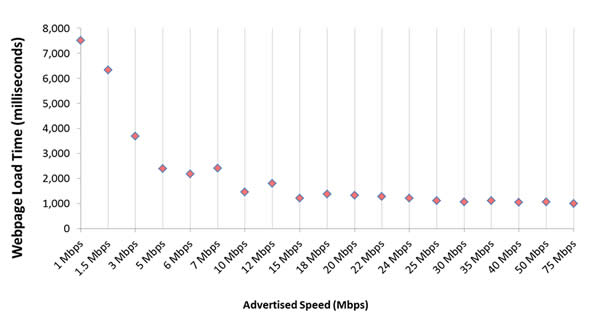
This tells us a lot about the Internet. Basically, home connection speeds of more than 10 Mb/s don't buy you much faster downloads of a website. Why? The time for loading a web page is only partially dependent on your connection speed. It also depends on the speed of the backbone and the speed of data centers, all of which is a function of speed and latency which depends on equipment used, switching and server speeds and traffic. All these need addressing to make real improvements in the customer experience.
Since we live in a rural environment and our speeds on both cable modem and satellite service vary greatly - from ~15-20 Mb/s in the morning when everyone is at work and ~2 Mb/s in the afternoon and evening when everyone comes home to download from Netflix and Hulu, we suspect traffic is a big issue and needs addressing ASAP. More fiber, of course, makes a big difference.
China Imitates Chattanooga
China is testing a combination smart grid and FTTH PON system similar in concept to Chattanooga and Bristol, TN. The State Grid Corporation of China (SGCC) is running the smart-grid project using passive optical networking (PON) technology—a high-bandwidth data wiring that can be run inside electric power cables without interference. Around 86,000 premises in China have so far been connected to the grid; if the project goes nationwide, it would cost around $2 billion to deploy.
SGCC was founded in 2002 as a pilot state-owned corporation by the State Council. As a backbone state-owned enterprise that may affect national energy safety and economic lifelines. SGCC's core business is to build and operate power grids and provides secure and reliable power supply for the development of the society.
Read more in MIT Tech Review.
MRG Report: More Than 2.2 Million Small Cells Will Require Backhaul by 2017
Small cells are being increasingly implemented into cellular networks. In 2011, small cells only had about 3% of the capacity that macro base stations had. By 2017, with the prevalence of outdoor metropolitan picocells, small cells will have roughly 19% of the overall capacity of macro base stations.
In terms of backhaul, not all small cells will require it. As an example, in residences, femtocells use either DSL or cable modems for backhaul. However, outdoor metropolitan and indoor picocells, microcells, and a percentage of enterprise femtocells will require backhaul. In 2012, slightly less than 170,000 new deployed small cells required last mile backhaul globally. By 2017, 2.27 million small cells will require a backhaul medium.
There are no fewer than eleven backhaul medium types being used to backhaul small cells. Of these, five are wireline, and six are wireless. One thing is for certain about small cell backhaul, there will be small cell clusters. In 2017, microwave radios will be the backhaul medium used most to connect small cells with more than two million radios being used. A little more than one million small cells will be connected by fiber, and another 933 thousand will be connected by MM microwave radios.
The MRG Report is Available For Sale Here.
FTTH in MDUs (Multiple Dwelling Units)
When we talk about FTTH, we often assume we are installing the fiber to a “home” where it terminates in a optical line terminal (OLT) and services (voice, data and video) are delivered inside the subscriber’s "home." But since we may have detached single-family homes, row houses or living units in a large building, the situations can be quite different, requiring different architectures and installation practices. To clarify the options for fiber in MDUs, FOA has created a new page in our FTTx section of the FOA Guide to explain the options.
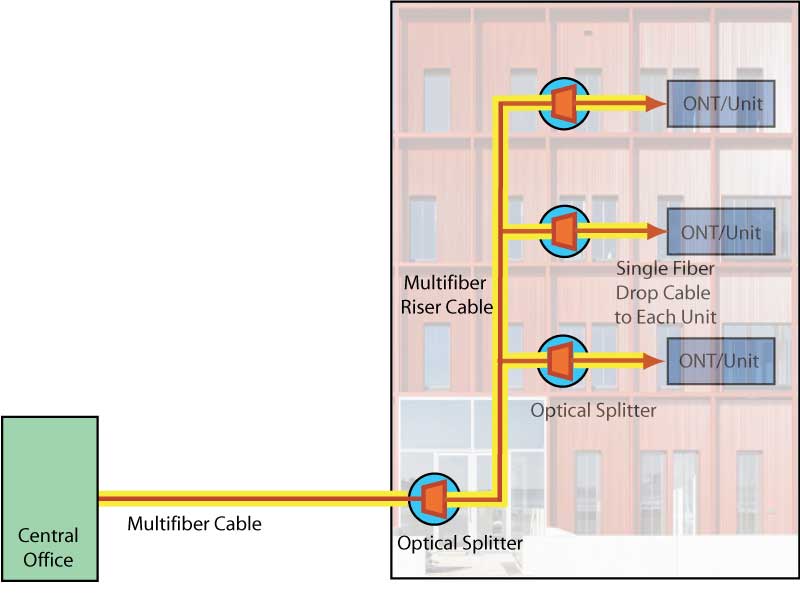
FOA Guide: FTTH in MDUs
FTTH Council Launches Online Resource to Support Quest for Gigabit Service
Community and business leaders looking to secure their economic future through ultra high-speed Internet connectivity now have a convenient online resource to assist them in upgrading local networks to all-fiber, as the Fiber to the Home (FTTH) Council Americas recently launched its Online Community Toolkit. The Toolkit offers an array of templates, white papers, case studies and other features that are designed to assist civic leaders, local telecommunications providers and other groups finance, plan and build all-fiber networks that are capable of delivering gigabit speeds and beyond.
Read more
Candlestick Park Gets "Fibered" - 500 Miles Of It
Candlestick park used to be the home of the San Francisco Giants. Now the San Francisco 49ers (who lost in Super Bowl XLVII this month against the Baltimore Ravens) play there.

Candlestick Park has been upgraded. Electrical work at the Santa Clara, California, stadium includes 16,000 lighting fixtures, 11,900 electrical outlets, 5,500 fire alarms, 500 miles of fiber optic cable and 900 wireless access points. That's enough wire to link California to Nebraska. And staying on the numbers theme, the back-up generator to the stadium is large enough to power 4,000 homes. From WiredInUSA.
Lennie Lightwave's Guide To Fiber Optics Now A FREE iBook
Lennie Lightwave was the cartoon character mascot of the original "Fiber U" in 1993. A short book called "Lennie Lightwave's Guide To Fiber Optics" became the way most people got started in fiber optics with the distribution of 60,000 printed copies and Lennie becoming one of the first commercial websites. Lennie is still on the web at http://lennielightwave.com, fully updated to today's technology and just as popular!
Now Lennie is available as a FREE iBook on Apple's iTunes store. If you have an iPad, you can go to the iTunes store, choose "Books" and search for "Lennie Lightwave" to get your free copy.
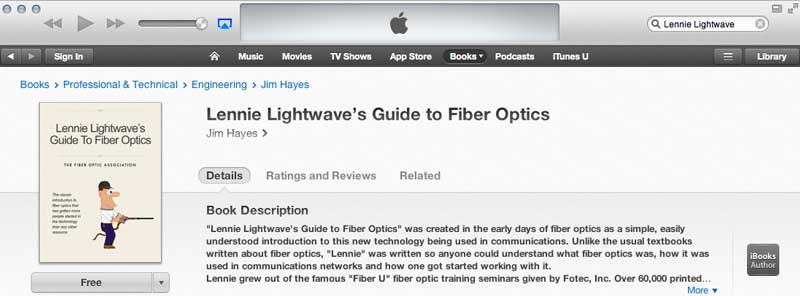
What Is Going On Here?
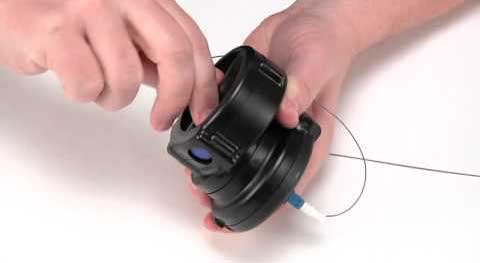
This person is polishing a 3M Crimplok(tm) connector. The connector is a crimp and polish connector that uses this special tool to complete the termination. There is a video on the 3M page showing how it works. Here is a page full of 3M videos on this connector and more 3M products.
Helping Solve The Patch Cord Problem
Patch panels are often a mess, with cables running in all directions causing - at least after some moves, adds and changes - a big mess. TE Connectivity (AMP to us old-timers) is now offering a new 1.2mm cable design for patchcords that can help reduce the mess.

The 1.2mm patch cord requires half the physical space needed for small form factor 1.6-mm patchcords, one-third of the space needed for commonly-used 2.0-mm patchcords, and is up to 3 times the strength of these larger diameter cables. Available with singlemode SC and LC connectors, the 1.2mm cable enables higher equipment densities in smaller space, while reducing capital and operating expenditures.
Compare the size of the cable to the size of the LC connector above. It's hardly larger than typical 900 micron tight buffer fiber!
One reason this cable is possible is the use of bend-insensitive fiber - reduced bend radius fiber as TEC calls it. We're seeing more BI fiber in premises applications because it allows smaller, more rugged cables that are easier to install.
Read more on the TE Connectivity 1.2mm cable design.
Information on other new products.
European Union Slashes Broadband Funding
In response to the region’s ongoing fiscal difficulties, officials of the European Union February 8 agreed to a Multiannual Financial Framework (MFF) for the years 2014 through 2020 that is approximately 80 billion euros smaller than the European Commission (EC) requested. About 10% of that savings will come from gutting the Connecting Europe Facility project that EC Vice President Neelie Kroes had hoped would fund broadband access network deployment.
Lightwave
Recognize This Fiber Comm System? Want To Buy It?
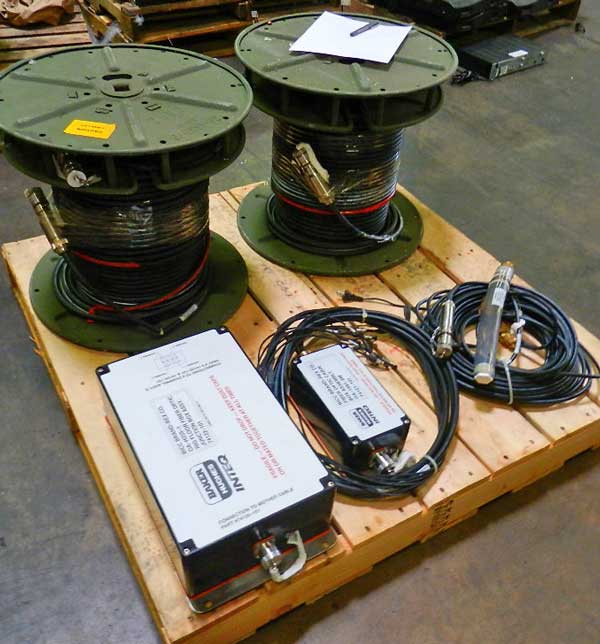
A company in Houston, TX that deals in surplus gear sent us this photo asking if we could recognize the hardware. We could not, but offered to post photos in our newsletter to see if anyone knows what it is and wants to make an offer on it.
Here are more photos and a contact for the seller.
OLANs - Optical LANs - Topic For CI&M Webinar March 27
FOA will be working with Cabling Installation and Maintenance magazine to present our third webinar - this time on OLANs. We will cover the history of cabling for LANs and look at the evolution of cabling for today's high speed networks.
More on the webinar at http://www.cablinginstall.com/webcasts/2013/03/passive-optical-lans.html
Register at http://video.webcasts.com/events/pmny001/viewer/index.jsp?eventid=45518&adid=ws
OLANs - Resources
Over the last couple of years, we've written a lot about all-optical LANs, either based on FTTH passive optical network (PON) or point-to-point (P2P) Ethernet architecture. The more we see of these types of networks, the more we appreciate their design and economy. But how about scale - how big can they get?
In November, we ran a picture story about the new San Diego Central Library which is using a Tellabs optical LAN using PON technology that was using about 1000 4 port drops. Now we hear another Tellabs customer has over 16,000 users. That must make it one of the biggest LANs in the world.
Here are more sources of information on optical LANs - BTW, they need a name - let's start calling them OLANs!
Tellabs
Motorola
Cliff Walker's FTTO paper
3M on POLs
And the new FOA Lecture 30, OLANs, Optical LANs
More "Quickstart Guides"
In our continuing quest to help people understand how to test fiber optic cable plants and communications systems, we've created two more "QuickStart Guides to Fiber Optic Testing." They are simple, step-by-step guides on how to test fiber optic cable plants, patchcords or single cables using insertion loss or OTDR techniques and optical power from transceivers. It's as straightforward as it can get - what equipment do you need, what are the procedures for testing, options in implementing the test, measurement errors and documenting the results.
It can't get much simpler.
Send anybody you know who needs to know about fiber optic testing here to learn how it's done in a few minutes.
Testing Fiber Optic Cable Plants And Patchcords
Testing Fiber Optic Cable Plants With An OTDR
Measuring Optical Power In Communications Systems

New FOA Lectures
We've added lectures on new topics, the characterization of optical fibers for CD, PMD and spectral attenuation, important issues for long haul systems and DWDM, POF and OLANs..
FOA Lecture 28, Fiber Characterization
FOA Lecture 29, Plastic Optical Fiber (POF)
FOA Lecture 30, OLANs, Optical LANs
We also added a Premises Cabling lecture on counterfeit Cat 5 cable, with a demonstration of its flammability.
Premises Cabling Lecture 11: Counterfeit Cat 5 Cabling
2 New "Hands-On Hints" Videos:
We've added two "hands-on" videos with hints on using OTDRs and microscopes for visual inspection. Watch for more hands-on videos.
Using an OTDR
Visual Inspection of Connectors With A Microscope
Lectures On Instructor Training
A new section of the FOA YouTube channel is all about teaching fiber optics and premises cabling. It's designed to help instructors working toward FOA CFOS/I instructor certification but is also useful to anyone teaching fiber or premises cabling. See below.
Followup: The Year of The OTDR
Last year we ran monthly features on OTDRs to try to increase user awareness of the proper way to use these instruments. We hope we made some progress.
Quick Start Guide For OTDRs
We added to our Online Guide is a new "Quickstart Guide" on using OTDRs which we hope will help users operate them properly:
Quickstart Guide: Testing Fiber Optic Cable Plants With An OTDR
Online OTDR Training
We also have started a online, instructor-led course on OTDRs using LinkedIn. It's on the FOA "Fiber Optic Training" group. Here are Part 1 and Part 2. archived so you can read them anytime.
Fiberizer OTDR App Available Free as "Cloud Service"

Fiberizer Cloud – fiber optic testing data management solution in the cloud. A version of the Fiberizer app for iOS devices.
OptiXsoft and Agizer are glad to introduce Fiberizer Cloud for fiber optic data management and analysis. On the one hand being tiny companies OptiXsoft and Agizer have solid experience in fiber optic test equipment and software development and now offer the Fiberizer App for iPhones and iPads.
The new web service Fiberizer Cloud was developed from the view point of ordinary fiber optic engineers and their businesses. Now engineers have no need to store multiple copies of their OTDR traces on different PCs in tremendous number of nested folders; or to order expensive custom software. Fiberizer Cloud allows to store and analyze fiber optic testing data directly from the browser opened on desktop PC or notebook (iOS and Android mobile clients are coming soon too) connected to the internet wherever they are.
Currently Fiberizer Cloud registration is free and available here: http://fiberizer.com
YouTube video on Fibrizer: (http://www.youtube.com/watch?v=JRiTVDSEaug)
Three Good Practice Tools For OTDRs, All Free
FOA OTDR Simulator
You may already know that the FOA has a free OTDR Simulator you can download from our website (go here for directions) that allows you to practice using an OTDR on your PC, seeing the effects of changing setup parameters and analyzing dozens of real world traces. But here are two more tools that can be good for practice.
AFS OTDR Online Demo
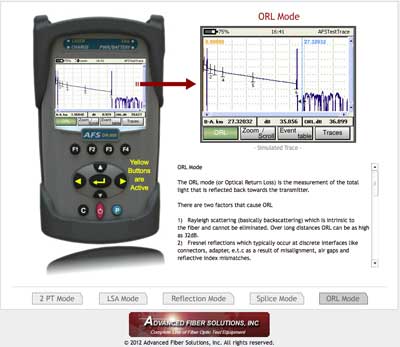
AFS has an online interactive demo of their new OTDR that allows you to see how an OTDR makes measurements. You use the yellow buttons in the center of the OTDR to set the markers to make measurements. Very well done. Go to http://www.afsi.us/otdr/otdr_mode.php for the demo.
"Fiberizer" APP Reads, Analyzes OTDR Traces
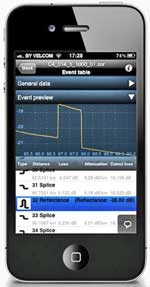
Fiberizer is a iPhone/iPad APP that reads industry-standard ".sor" format files and allows trace analysis on your iPhone or iPad. An android version is in the works too. Read more about Fiberizer. And here are more directions on its use.
OTDR FAQs
Including FOA Master Instructor Terry O'Malley's tests on what the end of a fiber trace looks like with broken and cleaved fibers.
Frequently Asked Questions On OTDRS And Hints On Their Use
 is now is now 
TIA’s Fiber Optics LAN Section Rebrands as Fiber Optics Tech Consortium
The TIA’s Fiber Optics LAN Section has changed its name to the TIA’s Fiber Optics Technology Consortium (FOTC). “Our new name better reflects our evolving scope,” says Rodney Casteel, who chairs the group. “There is so much opportunity now in the use of fiber optic technology beyond the Local Area Network (LAN) that it made sense for our group to embrace those changes. Fiber-based solutions are now integral to campus environments, data centers and other emerging applications. We are working to disseminate information about them all.”
Read More.
Events of Interest
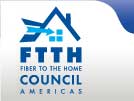
Community Toolkit Conference
A community toolkit for building ultra high speed networks.
May 29030, Westin Crown Center, Kansas City
The FTTH Council Americas is holding this special conference in Kansas City at The Westin Crown Center to provide communities with the Toolkit they need to deploy gigabit networks. Hear from those on the frontlines of the gigabit revolution—public and private sector leaders who have brought (or are bringing) ultra-high speed broadband to their communities. Through general sessions and interactive workshops, we will showcase the tools to get gigabit deployed, including an understanding of the value proposition of gigabit networks and how to create an asset inventory, aggregate demand, issue an RFP, and manage implementation.
More information at http://www.ftthcouncil.org/p/cm/ld/fid=71

OFC, perhaps the best show for fiber optics moves from LA to Anaheim this year, next door to Disneyland on March 17-21, 2013. Go here for more information and to register.
If you are involved in the management or marketing for a fiber optic company, you should consider attending the "Executive Forum" preceding OFC. It's a good time to get an update on the fiber optic market and meet some of the people making it happen.

The 2013 event will be the tenth annual Summit since the launch of the Towns & Technologies event series with an emphasis on fiber to the premises. Each year, the Summit has expanded its program, increased the number of attendees and attracted new sponsors and exhibitors. There were more than 950 registrants in 2012, and 1,000+ are expected for 2013. The 2013 Summit program will feature more than 45 sessions and 125 presenters, including prominent keynoters. For the fourth year, the Rural Telecommunications Congress will colocate its annual event, Rural TeleCon, with the Summit. Read more.
FOA presented a special webinar with Cabling Installation and Maintenance Magazine on "5 Ways To Test Installed Fiber Optic Cabling."
This webcast seminar, produced by Cabling Installation & Maintenance and presented by FOA President Jim Hayes, takes a hands-on look at each of these five standard test methods. Attendees will see the physical setup of each method and gain a thorough understanding of each method’s application as well as measurement uncertainty.
You can watch this seminar on your PC or Apple iPad or iPhone.
The seminar is archived on the Cabling Installation & Maintenance Website
FOA Presented a Webinar on Cabling Project Planning And Installation For CI&M Magazine
Topic: Cabling Project Planning - The Customer's Point of View
This webcast seminar was presented by FOA President Jim Hayes. In the seminar, Hayes will explain what is involved in a cabling-installation project (fiber, copper and/or wireless), from concept to acceptance. He will describe the step-by-step procedures, referencing which responsibilities fall on the end user, which fall on the contractor, and the critical points of cooperation between the two.
You can watch this seminar on your PC or Apple iPad or iPhone.
The seminar is archived on the Cabling Installation & Maintenance Website.
Free Corning "See the Light" Seminars
Corning Cable Systems' See the Light team is coming to a city near you! Receive Free fiber optic training on a variety of topics including Termination Technology, Testing and Trouble Shooting, Fusion Splicing, and Preterminated Solutions. These interactive three-hour sessions provide students with a comprehensive overview of the latest technology. Fiber optic BICSI (CEC) credits apply (3).
Here is the current information and schedule.
JDSU Testing Webinars
You are invited to join JDSU for a complimentary series of educational webinars. Each webinar, presented by a JDSU subject matter expert, lasts approximately one hour, including Q&A.
Go here to see the seminars offered. Search for "fiber" IMPORTANT: use registration password: FONA1.
Don't forget to download your copies of the JDSU Testing Textbooks.
 What's New @ FOA What's New @ FOA
FOA Standards For Contractors, Designers, Installers and Users
Read more about them here. And above.
Go to the FOA "1 Page Standards"
FOA Certifications Recognized By US Department of Labor
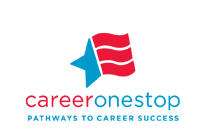
All FOA Certifications have now been recognized by the US Department of Labor. The DoL reviews certifications and how they relate to job opportunities and training. The DoL Career OneStop website helps individuals explore career opportunities to make informed employment and education choices. The Web site features user-friendly occupation and industry information, salary data, career videos, education resources, self-assessment tools, career exploration assistance, and other resources that support talent development in today's fast-paced global marketplace.
FOA Certifications Listed By US Department of Labor - Career OneStop
US Department of Labor Recognizes FOA In New "Occupational Outlook Handbook"
FOA is listed in the new US Department of Labor "Occupational Outlook Handbook" in the section "How to Become a Line Installer or Repairer."
This website lists all sorts of interesting information, including what these workers do in their jobs, how they get trained and certified (where the FOA is referenced) and something everybody is interested in - sections on "Pay" and "Job Outlook" - see the red arrow above.
FOA LinkedIn Group On Fiber Optic Training

FOA has started a new LinkedIn group called "Fiber Optic Training" dedicated to discussions on fiber optic training. Anyone can join our new Linked In fiber optic training group. We're experimenting on teaching instructor-led online courses on LinkedIn - watch for announcements on the FOA LinkedIn group and Fiber Optic Training Group. Take a look and join the group.
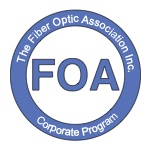 Corporate Memberships Corporate Memberships
FOA is now offering corporate memberships to companies involved in fiber optics as manufacturers, contractors, installers, etc. Among other benefits, Corporate Membership gives companies access to special FOA materials for educating customers and employees. Read more.
FOA Standards:
FOA has joined the American National Standards Institute (ANSI) to be able to keep up to date on more standards activities.
FOA now offers free standards for testing the installed fiber optic cable plant, patchcords and cable, optical power from transmitters or at receivers and OTDR testing. Look for the "1 PageStandard" web page and in the FOA Online Reference Guide.
Go to the FOA "1 Page Standards"
Free For FOA Members: NECA/FOA 301 Fiber Optic Installation Standard
Because of its importance to users, contractors and installers of fiber optic networks, The FOA and NECA have agreed to make the NECA/FOA 301 Fiber Optic Installation Standard available free to FOA members. It's specifically written to be used in contracts to define "installation in a neat and workmanlike manner." FOA members can go here for instructions on how to download your free copy.
FOA is a member of:


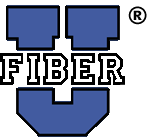
Three New Free Fiber U Self-Study Programs on Testing, Design and FTTx
There are two new free online self-study programs on Fiber U. Fiber Optic Network Design is for those interested in learning more about how ot design fiber optic networks or studying for the CFOS/D certification. FTTx is for those wanting to know more about fiber to the "x" - curb, home, wireless, etc. - or studying for the CFOS/H certification.
Got to Fiber U for more information.
We are considering using these self-study courses as part of online instructor-led courses using Linked-In. We have a new LinkedIn group, "Fiber Optic Training" (see below) which will be used for this. Join now for these courses.
- Reference Books for FOA Certifications are now available on Kindle and iPad/iPhone
  
We have created three new FOA books to be used in training for FOA certifications and as reference books for contractors, installers and end users of fiber optics. These books have full curriculum support, including free curriculum materials for teaching FOA certification courses. Because we are self-publishing these books using more modern "publish on demand" technology, they are easier to keep up to date, easier to buy and much, MUCH cheaper!
All are now available in print and electronically in Kindle and Apple iBook versions. The basic fiber optic book is also available as a self-study program in an Apple APP for iPad/iPhone/iPod.
Details on the new book each of the new books are at the book pages linked to the photos above.
FOA iPad Apps
The FOA has just released its second APP for the iPad, a free "loss budget calculator," FOA LossCalc.
FOA LossCalc
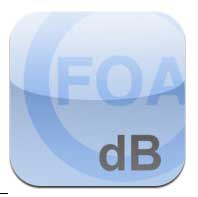 FOA LossCalc estimates the optical loss of a fiber optic link. This will save time for the installer of a fiber optic link needing to know whether test results are reasonable and/or make a "pass/fail" determination. It can also help the designer of a link to determine if communications equipment will operate over this link. FOA LossCalc estimates the optical loss of a fiber optic link. This will save time for the installer of a fiber optic link needing to know whether test results are reasonable and/or make a "pass/fail" determination. It can also help the designer of a link to determine if communications equipment will operate over this link.
By choosing the type of link (singlemode or multimode) and specifying the length of the fiber and numbers of connections and splices, it will calculate the end to end loss of the link. The app has default specifications for singlemode and multimode links or the user may create custom setups with specifications appropriate for any application. http://itunes.apple.com/us/app/foa-losscalc/id476262894?mt=8&ls=1
Self -Study in Fiber Optics
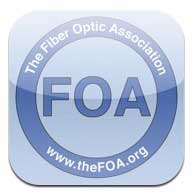 Our first app is a self-study version of the FOA Reference Guide to Fiber Optics. The FOA APP builds on the FOA basic fiber optic textbook to create an interactive learning environment that builds on the iBook electronic version of the book to add a guide to use for self-study and real-time testing that provides feedback on what you have learned and correct answers to questions answered incorrectly. Our first app is a self-study version of the FOA Reference Guide to Fiber Optics. The FOA APP builds on the FOA basic fiber optic textbook to create an interactive learning environment that builds on the iBook electronic version of the book to add a guide to use for self-study and real-time testing that provides feedback on what you have learned and correct answers to questions answered incorrectly.
The FOA APP is priced at only $9.99, same as the iBook, so the self-study program is free. Download it from the Apple APP Store with your iPad or iTunes.
http://itunes.apple.com/us/app/foa-guide/id434354283?mt=8&ign-mpt=uo%3D4
NECA/FOA 301 Installation Updated
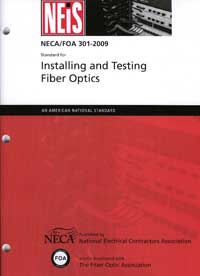
Standards cover components and systems and how to test them, but rarely get into installation issues. The FOA NECA 301 standard which covers installation of optical fiber systems has been revised for the second time, adding considerable new materials. This standard is derived from FOA educational material put in standards form and approved by ANSI as an American National Standard. It's specifically written to be used in contracts to define "installation in a neat and workmanlike manner." The standard is available from NECA. FOA members can go here for instructions on how to download your free copy.

New FOA Lectures
We've added lectures on new topics, the characterization of optical fibers for CD, PMD and spectral attenuation, important issues for long haul systems and DWDM, POF and OLANs.
FOA Lecture 28, Fiber Characterization
FOA Lecture 29, Plastic Optical Fiber (POF)
FOA Lecture 30, OLANs, Optical LANs
We also added a Premises Cabling lecture on counterfeit Cat 5 cable, with a demonstration of its flammability.
Premises Cabling Lecture 11: Counterfeit Cat 5 Cabling
Hazards Of Counterfeit Cable
You may have read the stories we have written about the counterfeit "Cat 5" cable made from copper-clad aluminum rather than pure copper. Recently we tried an unscientific burn test on the cable compared to a known good UL tested cable and posted a video on YouTube. You can see the results below.
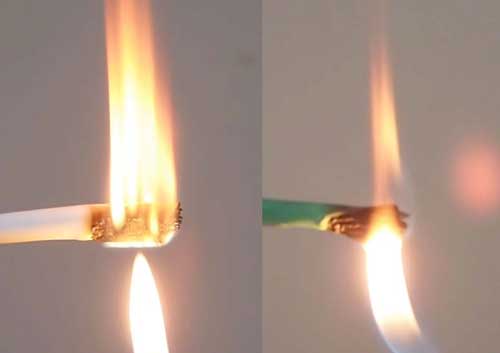
Counterfeit Cable Real UL-rated cable
The difference is obvious and the danger is real. Watch the video on YouTube: Premises Cabling Lecture 11: Counterfeit Cat 5 Cabling
2 New "Hands-On Hints" Videos:
Using an OTDR
Visual Inspection of Connectors With A Microscope
Below is a list of all the current lectures (plus there are 28 hands-on videos too!). We're looking for ideas for topics for future lectures. Send your ideas to <info@thefoa.org>.
Hands-On Fiber Optic Videos show how it's actually done
Using an OTDR
Visual Inspection of Connectors With A Microscope
Fiber Optic Connector Polishing Technique
The Fiber Optic Tester In Your Pocket (Cell Phone)
Insertion Loss Testing
Fusion Splicing
Mechanical Splicing
Fiber Optic Termination, Part 1, Setup & Tools
Fiber Optic Termination, Part 2, Jacketed Cable Prep
Fiber Optic Termination, Part 3, Adhesive Prep
Fiber Optic Termination, Part 4, Stripping Fiber
Fiber Optic Termination, Part 5, Connector Attachment
Fiber Optic Termination, Part 6, Polishing
Fiber Optic Termination, Part 7, Inspection
Fiber Optic Termination, Part 8, Distribution Cable Termination
Fiber Optic Cable, Part 1 Introduction
Fiber Optic Cable, Part 2, Zipcord
Fiber Optic Cable, Part 3 Distribution Cable
Fiber Optic Cable, Part 4 Breakout Cable
Fiber Optic Cable, Part 5 Loose Tube Cable
Fiber Optic Cable, Part 6, Armored Cable
Lectures On Premises Cabling
The FOA has added more videos to our YouTube Channel, thefoainc. These are an introduction to premises cabling, covering applications, types of cabling, standards and installation practices for copper (UTP and coax), fiber and wireless. Like our lecture series on fiber optics, these provide a comprehensive introduction to the subject in short videos, typically 5-10 minutes in length, on each subject. Watch for more.
Premises Cabling Lectures on YouTube
"Hands-On" UTP Cabling Videos show how it's actually done
UTP "Cat 5" Cabling, Part 1, Tools
UTP "Cat 5" Cabling, Part 2, The Training Board
UTP "Cat 5" Cabling, Part 3, UTP Cable
UTP "Cat 5" Cabling, Part 4, 66 Block Punchdown
UTP "Cat 5" Cabling, Part 5, 110 Block Punchdown
UTP "Cat 5" Cabling, Part 6, Jacks
UTP "Cat 5" Cabling, Part 7, Testing
UTP "Cat 5" Cabling, Part 8, Plugs and Patchcords
Lectures On Instructor Training
A new section of the FOA YouTube channel is all about teaching fiber optics and premises cabling. It's designed to help instructors working toward FOA CFOS/I instructor certification but is also useful to anyone teaching fiber or premises cabling.
FOA Instructor Training and Certification Playlist (all videos)
FOA Instructor Training - Part 1 -Introduction
FOA Instructor Training - Part 2 - About The FOA
FOA Instructor Training - Part 3 - FOA Approved Schools
FOA Instructor Training - Part 4 - Instructors
FOA Instructor Training - Part 5 - Curriculum
FOA Instructor Training - Part 6 - Teaching A Course
FOA Instructor Training - Part 7 - Hands-On Labs
FOA Instructor Training - Part 8 - FOA Resources
View all the FOA YouTube video Lectures.
What's New in the FOA Online Fiber Optic Reference Guide
We have been updating the Online Reference Guide to keep up with changes in the industry and adding lots of new pages of technical information.
FTTH in MDUs
A new page on the FTTH section on fiber inside buildings with multiple dwelling units.
Three new "Quickstart Guides" for fiber optic testing: cable plant & patchcord loss, power and OTDR
OLans: Optical LANs
FTTx and Design Pages Updated
As we developed the new Fiber U self-study courses, we updated the FTTx and Design pages and added a FTTx installation section.
Testing FTTH
Basic guidelines for testing FTTH PON networks
Learn More About OTDRs - Download a Free OTDR Simulator
More and more installers are being asked for OTDR testing but using these instruments is not easy. They are hard to set up properly and complicated to interpret the traces. Using the autotest function can lead to disastrous results! The FOA has a good tutorial on OTDRs on our Online Reference Guide and we added a free download of an OTDR simulator to the OTDR section so you can learn how to use an OTDR on your PC.
More New Info:
Links to manufacturers and distributors of fiber optic lighting products.
The FOA Online Fiber Optic Reference Guide has become very popular - perhaps the most popular technical website ever, typically with over 360,000 users downloading about 1.75 million pages in 2011! We continue updating materials regularly, keeping it as up to date as possible.
Find What You Want Using "Google Custom Search
 There's so much information on the FOA Tech Topics and Online Fiber Optic Reference Guide that even a well-organized Table of Contents isn't enough and when the material is always changing, an index is impossible to maintain. So the FOA is using the latest technology in search, Google Custom Search, which will allow you to search just the FOA Tech Topics and Online Fiber Optic Reference Guide for any topic you want to find more about. Try it! There's so much information on the FOA Tech Topics and Online Fiber Optic Reference Guide that even a well-organized Table of Contents isn't enough and when the material is always changing, an index is impossible to maintain. So the FOA is using the latest technology in search, Google Custom Search, which will allow you to search just the FOA Tech Topics and Online Fiber Optic Reference Guide for any topic you want to find more about. Try it!
Go to The FOA Online Fiber Optic Reference Guide.
School News
Quote from one of our certified instructors: I want to thank you and your organization for all the resources you provide for the students and the opportunity to offer the certification to the students. The fact that you published the book yourself to get the cost down and the unlimited free resources on your website shows a commitment to the public that is second to none. I let it be known to the students that the FOA is the best in the industry at supplying knowledge and resources related to the communication industry. I look forward to passing on the information that you provide for the industry.
New Schools
The FOA welcomes the newest additions to our listing of FOA-Approved Training Organizations:
#179- Camden College
#331- 3C Dynamics
#743- 3CNET
Find a listing of all the FOA-Approved schools here.
It's Now A Lot Easier To Find A FOA-Approved Training Organization
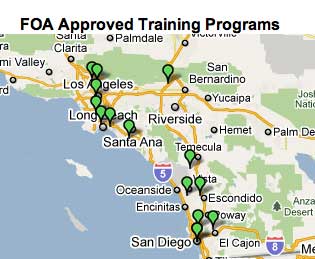
Most phone calls we get regarding finding a FOA-Approved training organization want to know two things: what school is closest to me or what school offers the certifications I need. That can be difficult, since the FOA has almost 200 training organizations we have approved worldwide!
We've been looking at ways to make it easier, and we think we've got a good solution. In fact we have two solutions.
First we have added a sortable table of all the FOA-Approved schools.
You can also use our FOA Google Map Application to find FOA-Approved schools.
Here are links to the sortable table of all the FOA-Approved schools and FOA Google Map.
What Should A Fiber Optics or Cabling Tech Know and What Skills Do They Need?
The FOA has been updating its lists of KSAs (Knowledge, Skills, Abilities) for fiber and cabling techs. The updated list is now on the website for your information and comments - as fiber and cabling KSAs evolve as new technologies develop.
KSAs for fiber and cabling techs.
Good Question! Tech Questions/Comments Worth Repeating
Tech Hint: Did You Know You Have A Fiber Optic Tester In Your Pocket?
Yes! That old mobile phone has a camera which may be sensitive to infrared light - lots more than your eye - and can detect light in an optical fiber or from a transmitter. Chris Hillyer,CFOT/CFOS/I, Master Instructor, Northern California Sound & Communication JATC sent us some photos showing how this works. See below or the video now on YouTube. Update: You should check out your old cell phones before you recycle them. We've found older models use sensors which are better at infrared than the newer ones which take better pictures. This is a good use for your old cell phones hiding in the drawer!
Number of Modes (2/13)
Q: How many modes can travel down a multimode fiber at the same time.
A: It's something one can calculate based on the core index profile, diameter and wavelength of the light.
A typical multimode fiber at 850nm carries hundreds of modes, a single mode fiber at 1310nm carries one.
Here is a very technical article:http://www.rp-photonics.com/multimode_fibers.html
But you can see the effects in two FOA YouTube videos.
FOA Lecture 21: Visual Fault Locator Demonstration shows the extra modes transmitted in singlemode fiber when transmitting 650nm red light below the singlemode cutoff
FOA Lecture 22: Mode Power Distribution in Multimode Fibers Demonstration shows many modes in multimode fiber using the same 650nm laser. At higher wavelengths like 850nm, there are many more modes than shown here.
Jim
Cable Colors (1/13)
Q: We have a customer building a Data Center. The customer will be using OM3 Fiber optic for backbone an there will be 2 diverse paths. Now the customer is asking to provide 2 different colors of OM3 cable and same 2 colors of patch cord on OM3. Is it correct to use different colored cables other than the standard aqua for OM3 fiber?
A: Yes, it is OK to use different colors of cables to identify cables in diverse paths. The "standard" color for OM3/OM4 cables, aqua, is a recommendation but it's not uncommon in large enterprise networks and data centers to see lots of different cable colors.
Flashlight Test? (1/13)
Q: We are trying to troubleshoot a fiber cable by using a flashlight pointed in one end and seeing if it comes out the other end...(I know a bit low tech but..) The distance seems to be too great to get the light of the flashlight to come through.
What tool out there can help with this issue?
A: A "flashlight test" is often used for a continuity or polarity check. The problem is getting the flashlight aligned with the fiber and coupling sufficient light to be able to see anything. For multimode fiber going short distances (a few hundred meters), a flashlight with a alignment fixture can be sued, like this http://www.afsi.us/product.php?product=CONTINUITY
For singlemode fibers you need a more powerful source that is carefully focused for the small core of the fiber, like this http://www.afsi.us/product.php?product=AF-OS405
But in reality, all installations should be tested for loss with a light source and power meter. See here for an overview: http://www.thefoa.org/tech/ref/basic/test.html
Online Discussions (12/12)
Q: I was wondering if the FOA might think about adding a feature to the FOA website… Like a technical discussion forum… or other member forums for discussion.
A: We use LinkedIn for those kinds of technical conversations. We have a CFOT group and a Fiber Optic Training group that are pretty active. Anyone can join the FOA Fiber Optic Training Group or join the FOA Group if you are a CFOT.
MM to SM Adapter (12/12)
Q: Is there a coupler on the market to hybrid SM and MM to avoid high dB loss in that even?
A: No! Several people have tried to make tapered fibers to mate different fiber sizes but none successfully. You need electronics to do it.
Matching MM Fiber For Launch/Receive Reference Cables (12/12)
Q: These days fiber cable is not simply 62.5um or 50um - we now have 3 different grades of 50um fiber......ie. OM2, OM3, OM4. How important for cables to be matched for this?
A: The difference between OM2/3/4 fiber is the structure of the core used to increase the bandwidth. Since all these fibers are designed to have the same core diameter and NA, doing insertion loss tests with mixed types is not a problem. However, many of these laser-optimized fibers are not made as "bend-insensitive fibers and mixing those fibers with regular fibers can be a problem.
Testing Cables With Expanded-Beam Connectors (12/12)
Q. How do I test cables with expanded-beam connectors?
A. Since most meters have smaller detectors they may not capture all the light from these connectors, so a 3-cable reference with a known good cable of the type under test is probably the best method to use. See here and here in the FOA Guide.
Removing Obsolete (And Valuable) Copper Telephone Cables (11/12)
Q: In our FTTH build-out we have changed a large number of customers from copper to fiber. There is a huge amount of copper underground lying free. (Inside ducts) The issue is that in the access network most are together with new fiber cables (no sub-ducts). In the primary routes there are large count copper, say 2000 pairs and above too. So pulling out wont be easy and need to be done by a specialized party. There is a large amount of money down below! I hope you can give me some guidance and refer me to the right company or the right person to get an idea.
A: Yes at the current price of copper this is indeed a very profitable "mining" venture! A web search for "removing copper cables from underground ducts" gives lots of leads, but the company I remember talking to is "Cable-X" http://cable-x.net/what-is.htm which is based in the Netherlands.
Would FTTO Work? (11/12)
Q: We have a project we are working on and I had a few questions: The project is a large indoor mall. The mall wants to add public WiFi. Would FTTO work for this application?
A: This is an ideal application for FTTO. You would use singlemode fiber and would need to add power at the antenna locations for the wireless access point and a media converter or switch. One advantage is flexibility of placement of APs in a large facility with direct connections to just one equipment room. I would look at prefab cable assemblies too- you might be able to avoid field termination or splicing.
Mode Conditioning Patch Cables (11/12)
Q: Something new came up in a discussion with a network engineer. He told me about “mode conditioning patch cables”. What are they?
A: They were originally used for Gigabit Ethernet at 1300 nm using laser sources. 1000Base-LX sources were lasers with singlemode pigtails. Multimode fibers of the era were notorious for having incomplete fusion of the glass in the center of the core which caused bandwidth problems. Mating a SM pigtail laser to one of these fibers caused big bandwidth problems since they launched right into the center dip. The immediate solution was to set up an offset launch to avoid the center of the fiber with LX sources. VCSELS had problems with these fibers too, even though they launched a much larger spot, so the laser-optimized 50/125 OM3 fibers were developed to not have the center dip and OM4 followed soon thereafter. 10GBASE-LX4 had the same problem, of course, only worse, with OM1/2 fibers and SM lasers. The patchcords are usually made by splicing SM to MM fibers with an offset of ~10 microns. I cannot say I know anyone who has actually used them! 1300 nm has no advantage with MM fiber as the bandwidth has been optimized for 850nm. And they are much more expensive than 850nm VCSELs. It is unlikely you need them with OM3/4 fiber and I would not recommend running 10G over OM1/2 without some field trials.
Restoration
Q: Do you have any data on Mean Time to Repair (MTTR) statistics available for fiber cable outages?
A: We break the MTTR into two stages - finding the break and fixing it.
Finding a break is often much simpler than you think - somebody sees it happen! Although I do know of an instance in Chicago where a cut was located by OTDR and when the crew drove to the site found a sign company pushing broken ends of the fiber cable back into the hole they were digging with a big auger to hide it!
The textbook response talks about using an OTDR to find the break, but that is probably a less likely solution for many dig-ups or accidents bringing down utility poles, more likely for rodent penetration or damage during directional boring in underground cables or, as one guy I know from Bonneville Power succinctly described it, "target practice" on aerial cables. Needles to say, you need to know how to use an OTDR and how to estimate the actual cable length as the OTDR measures fiber length not cable length. Here is info on OTDRs OTDR testing
Once you find it and are at the site with the proper tools and components, fixing it can be estimated as the usual splicing or termination time. We have articles on our website that discusses estimating installation time that covers restoration as well. Estimating Fiber Optic Installations and Estimates of Splicing Times for Various Cable Configurations
The FOA has created a guide to restoration for network users and contractors that you may find helpful. Feel free to share it and reprint it as needed. Planning For Restoration (PDF, 0.1 MB) We also cover it in our OSP Guide.
Fiber Cleaning
This is a topic we keep reminding everybody about, and here is why:
From a contrator in the Middle East: Here some samples of the connectors for SM fiber already installed in the system we were testing.
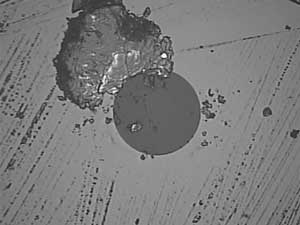 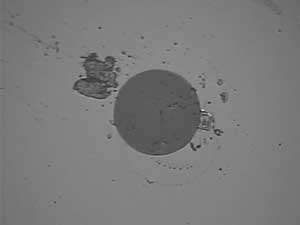
As you can see, the dirt is large compared to the size of the fiber (dark gray), and the core (not visible here) is only 9/125 of the overall diameter of the fiber! More on cleaning. See Product News below for links to vendors of fiber cleaning products.
See news about Fiber Optic Cleaning Videos on YouTube by ITW Chemtronics below.
Measurement Uncertainty: Everyone testing fiber optics should understand that every measurement has some uncertainty - whether you are measuring loss, length, wavelength, power, etc. Knowing that uncertainty is very important to interpreting the measurement. It's worthwhile to read and understand the issue of measurement accuracy covered in this page of the FOA Online Fiber Optic Reference Guide.
Worth Reading or Watching:
Recap: Recent FOA Newsletter Articles You Might Have Missed
Installing Fiber Optics
FOA President Jim Hayes is interviewed by Howard Baldwin for the CISCO BLOG on the issues of installing fiber optic cable and how to "think creatively." Read the blog.
Polishing Fiber Connectors
FOA Director Bill Graham makes the case for epoxy/polish connectors in this article in Cabling Installation & Maintenance Magazine.
How Is Fiber Manufactured?
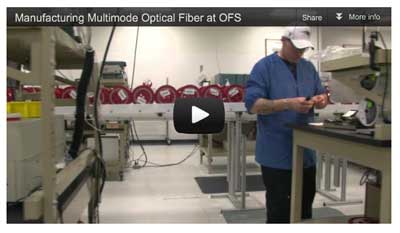
OFS invites you on a tour of their multimode fiber manufacturing facilities in this new 5-minute video. You will see their highly automated manufacturing operation in Sturbridge, Mass., including their patented MCVD preform fabrication process to fiber draw and final product testing. With a technological heritage dating back to AT&T and Bell Labs, OFS has been manufacturing high-quality multimode fiber since 1981.
Watch the video here.
Where Are The Jobs In Fiber Optics?
The August, 2012 FOA Newsletter presented a review of where we see the most active areas in fiber optics now and where the jobs seem to be most available. You can read this article here. If you are looking for a job, the FOA also has a web page on looking for jobs and a LinkedIn group for CFOTs where jobs can be posted,plus a jobs section in this newsletter.
FTTO: Fiber To The Office
At our seminars in the UAE with eSharp Consultancy, Cliff Walker presented information on his work designing "fiber to the office (FTTO) networks. The concept is based on using fiber to connect large switches in the equipment room to smaller switches with 4 ports at the outlet. You can read Cliff's paper on the airport system to see estimates of the cost savings using FTTO.
Read Cliff Walkers paper on FTTO.
More On Fiber Use In Wind And Solar Power
Craig Bowden, FOA Master Instructor at FiberNexxt in NH, presented a program at the New England Fiberoptic Council recently on fiber in wind power. His presentation is available for downloading here. It's full of good illustrations and photos that tell the story.
Jonard FOD 2000 Fiber Optic Drop Cable Slitter
The FOD-2000 Fiber Optic Drop Cable Slitter is a patent pending tool that simplifies the slitting of drop cable jackets at the end of the cable or mid-span. For Flat Cables. Wathc their YouTube Video: http://www.youtube.com/watch?v=B1H2zrW3k34
Making Sense of The G.657 Standard (OFS)
The G.657 standard was developed by the International Telecommunications Union (ITU) to provide consistency in the evolving requirements for bend-insensitive single-mode fiber.This OFS paper sums up the standard and what it means. Read more.
What's ahead for multimode fiber communication systems?
By Gastón E. Tudury, Ph.D., and Al Brunsting, Ph.D., Panduit
With networks like Ethernet moving to 40 and 100 Gb/s, current multimode fiber has been forced to a parallel optics solution, not considered acceptable by some users like Google, due to the masses of fiber needed for data centers. Rather than go to a singlemode WDM solution, these two suggest we should look at redesigning MM fiber, cutting the NA for higher bandwidth and maybe tweaking the VCSELs too. Lightwave.
In Pictures: The World’s Largest Solar Thermal Power Plant
BrightSource’s 370-megawatt facility near Las Vegas is taking shape, with lots of fiber optics being installed by FOA-certified techs..
http://www.technologyreview.com/news/428009/in-pictures-the-worlds-largest-solar-thermal/
Want To Know Where Submarine Fiber Optic Cables Run?
There is a good map online by TeleGeography you can access here.
Choosing the right connector: APC vs. UPC
An interesting article from ADC on the differences in APC and UPC connectors makes the choice easier. Read more.
Confused By Standards?
You are not the only one! As Bob Metcalfe, co-inventor of Ethernet, once said at a conference "The wonderful thing about standards is we have so many to choose from!" But the Siemon Company, an active participant in standards activities for decades, has tried to give some order to this chaos with a new website Standards Informant where they cover the TIA, ISO /IEC and IEEE standards that affect cabling and networks. If you need to keep up with standards, sign up for their email newsletter too.
Patchcords: You Get What You Pay For Says Siemon
Siemon is a global manufacturer of cabling products that has been a big contributor to international standards. Recently they tested patchcords procured from several sources and found out what you might expect - quality suppliers produced quality products but cheap suppliers supplied, well, you can read it here: http://www.siemon.com/go/fiberjumper
Benchmarking Fusion Splicing And Selecting Singlemode Fiber
We've been asked many times "How long does it take to splice a cable?" It's not a simple answer as it varies with the number of fibers in the cable and the work setup, including whether one or two techs are working at a job site. FOA Master Instructor Joe Botha of Triple Play in South Africa did his own analysis based on decades of experience both splicing cables and teaching others how to do it properly. This is one of the best analyses we have seen because Joe includes prep times as well as splicing times and differentiates between one tech and two techs working together. He adds some other tips on fusion splicing too. This should be mandatory reading for every tech and given to every student! Here is Joe's splicing analysis.
Joe also has an excellent writeup on how to choose singlemode fiber that helps understanding the different types of G.6xx fiber. Read it here.
And you will want to read Joe's report on splicing different types of SM fiber, including bend-insensitive (G.657) fiber. Read it here.
Videos on Firestopping: These free videos from UL and the International Firestop Council are good tutorials on firestopping. Go here to view the videos.
Micro-Trenching, Cable Removal
Nano-Trench offers products for micro (or I guess they call it nano-) trenching and their website is very informative. They also have Kabel-X, a method of extracting copper cables from old conduit. Both websites are informative and interesting. Watch this video on the cable removal process!
Free - Mike Holt's Explanation Of The US National Electrical Code (NEC) For Communications Cables
Mike Holt is the acknowledged expert of the US National Electrical Code (NEC). His books and seminars are highly praised for their ability to make a very complicated standard (that is in fact Code - law - in most areas of the US) easily understood. Part of the appeal is Mike's great drawings that make understanding so much easier. Mike makes Chapter 8 of his book available free. It covers communications cables, telephones, LANs, CATV and CCTV, for premises applications. Even if you live in a region or country where the NEC is not the law, you may find this interesting.
Download Mike's Chapter Here.
Fiber Optic Crossword Puzzles For Entertainment And As A CFOT Certification Study Aid (2/12)
Pearson Technologies Inc., a 32-year fiber optic training, technical and marketing consulting firm, announces availability of a free training and certification tool. This tool is a free set of crossword puzzles on the terms of fiber optic installation and products. This set assists those studying fiber optic installation or planning to take the Fiber Optic Association (FOA) Certified Fiber Optic Technician (CFOT) certification examination. The four puzzles are for: light and fiber terms, cable terms, connector and splice terms, optoelectronics and testing terms.
The puzzles can be viewed and printed from: http://www.ptnowire.com/resources.htm or http://www.ptnowire.com/CFOT-Puzzles-vb.pdf. Individuals can receive the answers by email request.
For additional information, contact Pearson Technologies Inc. at: 4671 Hickory Bend Drive, Acworth, GA 30102, at (770) 490-991, or via e-mail at fiberguru@ptnowire.com.
New Eric Pearson Books
A new book from Eric Pearson, Mastering Fiber Optic Network Design, has just been introduced (9/12).
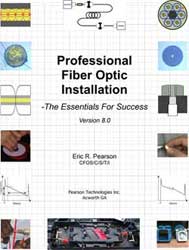 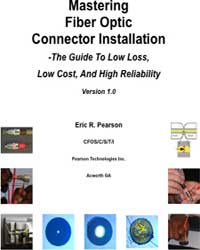 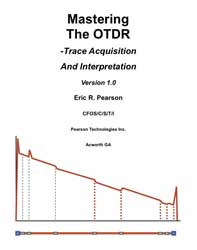
Pearson Technologies Inc. announces the release of four new books, Mastering Fiber Optic Network Design, Professional Fiber Optic Installation, The Essentials For Success, Mastering Fiber Optic Connector Installation and Mastering The OTDR.
Based on 32 years of experience, laboratory testing, development, and training of more than 8000 installers, these books is suitable for training, installation, personnel certification, and reference. Eric's books are perhaps best described as fiber optic "cookbooks," full of detailed directions that reflect many years of tesing in his courses. They are valuable references for the fiber optic tech.
For additional information. contact Pearson Technologies Inc., www.ptnowire.com, fiberguru@ptnowire.com, 770-490-9991
Fiber Optic Cleaning Videos on YouTube
ITW Chemtronics has three fiber optic cleaning videos on  covering Dry Cleaning, Wet-Dry Method, FiberWash and Combination Cleaning. They are good explanations of cleaning processes - the Wet-Dry is especially interesting. covering Dry Cleaning, Wet-Dry Method, FiberWash and Combination Cleaning. They are good explanations of cleaning processes - the Wet-Dry is especially interesting.
A Documentary Treasure on the History of the Internet
15 minutes of a rarely-seen BBC documentary demolish the myth that ARPAnet was inspired by nuclear war, and explain the far more intriguing truth.
http://www.technologyreview.com/blog/mimssbits/26719/?nlid=4433
Ensuring Distance Accuracy On OTDR Measurements
By JDSU.
Broadband Properties Webinar Archives

Lots of interesting webinars, mostly on FTTH. Go here.
FTTX Networks
An ADC white paper on how they work and how networks are upgraded to FTTH. http://connectedplanetonline.com/images/CP-ADC3-WhitePaper-v4.pdf.
JDSU Application Note On "Qualifying FTTH Network before Equipment Installation"
Another great paper from JDSU covering FTTH PON networks is available for downloading. It gives an overview of FTTH architecture, cleaning connectors then testing the cable plant with OTDRs and OLTSs. This paper will help you understand why OTDRs can be confusing on PONs!
Best Practices For Wireless Backhaul Network Upgrades
Joan Engebretson, Contributing Editor of Connected Planet has written a very good overview of how fiber is essential to the operation of cellular wireless systems. Everybody probably knows that fiber is used to connect towers into the telecom network - they call it backhaul - but her article also covers the new appliations to replace bulky, heavy, lossy coax up the tower to the antennas. http://connectedplanetonline.com/images/CP_ADC2_WhitePaper.pdf.
Fiber Optic Safety Poster
We've had numerous requests to reprint our guidelines on safety when working with fiber optics, so we have created a "Safety Poster" for you to print and post in your classroom, worksite, etc. We suggest giving a copy to every student and installer.
Corning now offers videos on  . Lots of interesting videos, some technical, some sales, but all good information. . Lots of interesting videos, some technical, some sales, but all good information.
US Conec's videos on cleaning fibers - show's the results of proper cleaning.
Webinars of Interest
Broadcast Engineering Magazine - Fiber Optic Testing
FOA President Jim Hayes presents an overview of fiber optic testing for all applications. Available on Demand. Sign up here.
Multimode Fiber Trends from TIA's Fiber Optics LAN Section
Ryan Chappell, Draka Communications, looks at the evolution of multimode fiber, examines its current usage and shares predictionson its future Available on-demand at: http://www.brighttalk.com/webcast/7182/play
OSP Magazine Webinars
OSP Magazine (OSP as in outside plant telco) is now offering a number of interesting webinars that cover fiber topics, including network design and specialized components. http://www.ospmag.com/events/web/
Multimode Fiber Characterization Launch Condition Considerations - new ap note from JDSU
JDSU Reference Guide to Fiber Optic Testing – Volume 2 Published
The second volume of the JDSU series on fiber optic testing has been published. Volume 1 focused on Basic Fiber testing and Volume 2 is geared toward fiber optic installers, project managers, telecom technicians and engineers who need to understand fiber networks. Volume 2 also covers Chromatic Dispersion, Polarization Mode Dispersion, Attenuation Profile and Fiber Link and Network Characterization. A 3rd volume, a glossary of fiber optic terms, is also available for download.
This is a "MUST HAVE" for all fiber optic techs. Download your free copies here.
We used this book as one of our references in creating a new page in the FOA Online Reference Guide on chromatic dispersion (CD) and polarization-mode dispersion (PMD).
Careers in Fiber Optics: Brian Smith. A 1998 book on fiber optic jobs is a bit dated, but a free overview is on Google Books and worth a look at it online.
Dirt!
As much as 70% of the problems associated with deploying fiber to the home result from something as simple as dirty connectors according to JDSU. Telephony Online.
US Conec's videos on cleaning fibers - show's the results of proper cleaning.
Good Technical Websites
American Polywater (http://www.polywater.com/) has one of the best technical website for cable installers. Here is a rundown on some new material on their site.
Cable Installation using "Push" or "Push/Pull"
Polywater's new Pull-Planner™ 3000 Software allows a "pushing force" variable in pulling tension calculations. Read a White Paper that quantifies the push contribution and compares calculation results to field experience. --
http://www.polywater.com/pushing.pdf
Pulling Cable Through Water?
Read a Product Spotlight on Polywater® + Silicone™, Polywater's new generation underground lubricant. Continued reduction of friction when pulling through water is only one of the unique features of this lubricant. --
http://www.polywater.com/NNNBSL.pdf
Check out their website, especially “Videos,” “Engineer’s Corner” and “Calculators.” http://www.polywater.com/NNNBSL.pdf

" Heard on the Street" is a monthly online newsletter from Frank Bisbee of Communications Planning Corporation that covers the telecommunications and cabling businesses. Each month includes news from manufacturers, trade associations and professional societies like the FOA. You can read the current issue and back issues online.

JDSU has announced the See the Light webinar series, a four-part program designed for anyone involved in the installation, maintenance, and repair of fiber optic systems. It begins with fiber inspection and cleaning and then covers the basics of fiber testing. The webinar series then continues with the more advanced optical time-domain reflectometer (OTDR) and fiber local area network (LAN) testing challenges. More information on the series.
IGI is offering a series of webinars on topics of interest to those in the communications industry. You can join them live ir download from the archives. IGI WEBINAR ARCHIVES UP AND RUNNING - VISIT TELECOMBRIEFINGS.COM TO DOWNLOAD!
IGI, a major market research and technology reporting company (the "Active Optical Cables" below) is offering a a free one year subscription to one of our fiber optics newsletters to FOA members. All they have to do is to send IGI an e-mail stating which newsletter they would like to get. See http://www.igigroup.com/nl.html for a listing of IGI Newsletters.
-
- FOA Tech Topics -
A Fiber Optic Tester In Your Pocket? (See the video on  ) )
Yes! The camera in your cell phone is sensitive to infrared light - lots more than your eye - and can detect light in an optical fiber or from a transmitter. Chris Hillyer,CFOT/CFOS/I, Master Instructor, Northern California Sound & Communication JATC brought this to our attention.
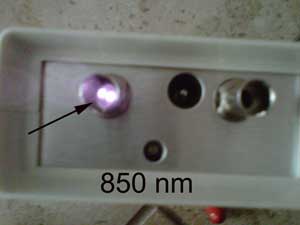 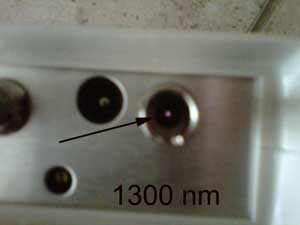
If you have an old cell phone, try it too. Our experience is that older cell phone cameras have better sensitivity at IR wavelengths than newer phones, so you may want to toss that old phone into the toolbox.
- FOA Technical Bulletins
- How do you design and manufacture fiber optic systems? Choose and install one to serve your communications needs? Troubleshoot problems? The FOA Fiber Optic Technical Bulletins will provide step-by-step guidelines to help you. All are PDF files you can download, print and use.
- Testing Update
- Are there really 5 different ways to test optical fiber cabling after installation? Why so many? How do the measurements - and more importantly the measurement results - differ? What are the advanteages and disadvantages of each method?
- Why are there 4 ways (maybe 5) to test fiber optic cables?
- Do OTDRs and OLTS tests give the same results?
-
- New Tech Topics
- Industry standards updated to include international standards
- Updated link specs for fiber optic networks - now includes 10/40/100G Ethernet.
Product News
Ruggedized Fiber Optic Comm System For Sale

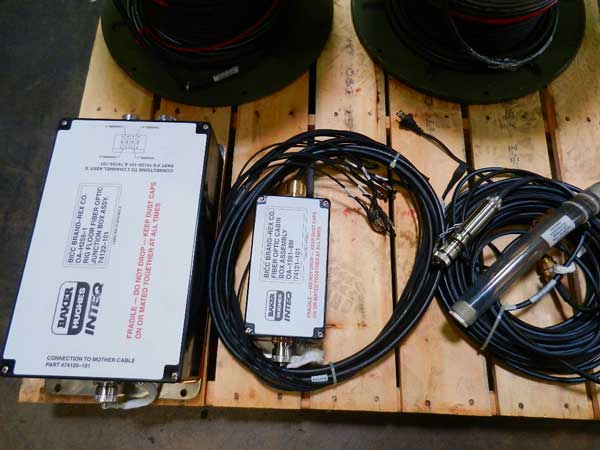

Here are photos of a system for sale in Houston. It could be military, undersea or ruggedized field unit for seismic research.
If you are interested, contact the seller directly
Lynn W. Miller
Asset Value Management Services
4647 Pine Timbers St. Ste 135
Houston, Tx. 77041
Phone: (713)-869-0200
Fax: (713)-869-0204
Email: lynn@avmsvc.com
Web: www.avmsvc.com
AFL Add More Cleaning Products
AFL enhanced its NOYES fiber optic connector cleaning product line with the addition of these new products:
AFL CleanConnect 500, a refillable cassette-type cleaner
NTT-AT NEOCLEAN-E series, refillable push-type cleaners
OPTIPOP-C, refillable card-type cleaners
Fujikura One-Click D-LC, a revolutionary push-type cleaner
KimWipes, optical grade cleaning wipes
CleanWipes™ optical grade cleaning wipes
AFL’s broad selection of cleaning products enables engineers and technicians to choose the products that match their current and future needs, and also comply with established cleaning procedures. These products are designed for ease-of-use in a wide variety of environments. More.
Cleerline "Non-Strip" Fiber Strips With Fingernails, Not Tools (12/12)
Cleerline Technology Group, an offshoot of D’Addario & Company, Inc. (yes, the people who make guitar strings, among other things), is offering a new type of fiber. They have a proprietary, patented coating technology that allows the tech to strip off the buffer coating with a fingernail when connectorizing in the field.
Watch their YouTube Video to see how it works.
Illuminated Fishtape: Why Didn't I Think Of That?
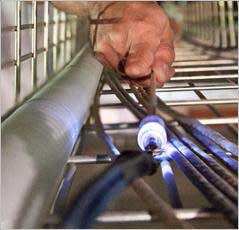
Klein Tools, (http://www.kleintools.com/) for professionals since 1857, introduces a new illuminated fish rod tip (Cat. No. 56119). The bright white, omni-directional light illuminates when fishing above ceilings, in attics, through walls, in crawl spaces and under raised floors. The hook or bullet nose attachments (sold separately) fit smoothly into the threaded top and the ends are tapered for easier pushing and pulling.
POF Link Transceivers
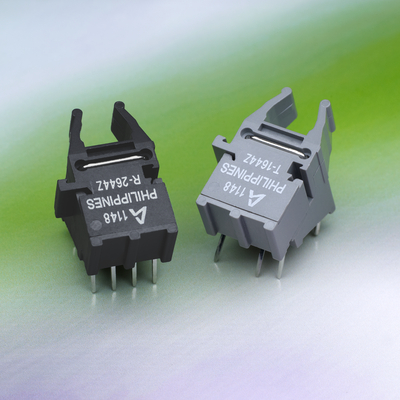
Enhancements to Versatile Link Plastic Optical Fiber Product Family include integrated digital driver and receiver logic. Avago POF products offer infinite voltage isolation and EMI immunity performance that far exceeds what can be achieved with traditional copper cable standards. POF cable solutions can weigh up to 75% less than copper cables, while providing similar or greater performance with a 50% tighter bend radius at comparable cost.Read More
Senko Connectors for Harsh Environments
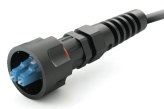
SENKO has introduced the IP-SERIES, an effective and low cost connector for harsh environmental applications. It withstands water immersion, dust and temperature ranges of -40 to +70C while providing low insertion loss. Available in LC, SC and MPO versions. Read More.
Handheld OTDR
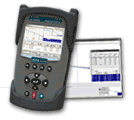
Advanced Fiber Solutions has introduced a new compact portable OTDR that offers high resolution (to 1m) and light weight (1.6 pounds, 0.72 kg) plus numerous wavelength and range options. Here is more information.
Micro-Trenching, Cable Removal
Nano-Trench offers products for micro (or I guess they call it nano-) trenching and their website is very informative. They also have Kabel-X, a method of extracting copper cables from old conduit. Both websites are informative and interesting. Watch this video on the cable removal process!
Protecting Pedestals From Rodents
Pedestals and underground vaults can be damaged by rodents who come up through the base and damage cables. Uraseal "Drain N'Seal" foam deters mice from taking up residence in your pedestals. They have some good videos on using their product.
Used Test Equipment – Buy or Sell
http://www.testequipmentconnection.com/
Have you read the FOA Tech Topics on Cleaning?
More links on cleaning:
Westover
- AFL
ITW Chemtronics
Cleantex Alco Pads
MicroCare
Seiko-Giken
-
- FTTH Notes:
Broadband Properties: Latest Issue has lots of FTTx News.
Google Map Shows Worldwide FTTx Projects
One of the better sites to track FTTx projects is this Google maps application that shows projects on a world map with details on the project.

Click on the map above or here to view the interactive web map.
Testing FTTH
JDSU shows how to test a PON with an OTDR: http://www.jdsu.com/other-literature/PON-OTDR_fop_an_ae.pdf
-
- Want To Learn More About FTTx?
- The FOA has created a special FTTx resources section of our website with a FTTx links page with lots of links to news, market reports, technical articles and vendor technical and product information. Here is a great place to start learning more about FTTx.
- FOA's CFxT FTTx Certification Program Explained
- Read the Broadband Properties article about the FOA FTTx certification program. Read the article about FOA President Jim Hayes being honored for his work promoting FTTH.
-
|

